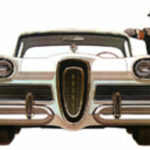A figure of speech is a rhetorical device that involves a particular verbal pattern, a repetition or other creative use of sound, or comparisons that amount to illuminating but technical falsehoods. Not much, seemingly, is done in the way of instruction in figures of speech at lower school levels any more, perhaps because of the classical roots of many of these devices. As everyone knows, all things classical fell out of favor about the time Ford pulled the Edsel out of production.
Thus, even upper class college students who are interested in writing will sometimes stall, if asked to write down all the figures of speech available to them as tools, after similes, metaphors, and personification. Some won’t even get to personification, and half of those who do won’t recall the difference between a simile and metaphor accurately.
Thus, we will attempt to clarify those devices available to all writers, but soon to be lost, apparently, because “I’m sorry, I’m really into American Idol; this one guy’s so cute” – with considerable credit to about.com, and specifically, about.grammar.com. They designate the following the “top 20 figures of speech” – some of the examples are theirs; some are those I present to my “creative writing” students:
1. Alliteration – repetition of an initial consonant sound.
A famous example of this figure is Spiro Agnew’s characterization of anti-war demonstrators in the 70s as “nattering nabobs of negativism.” What is a nabob? Originally, it meant a European who had made a lot of money in India; in a wider sense, it now means any wealthy person. So, Agnew may have been taking a swipe at rich, “arm-chair” liberals, or he may have thought of his noun as simply a synonym for “boob” or “idiot.” (I’d vote for the latter although most of the demonstrators in the streets were college students, and presumably had some money.)
2. Anaphora – repetition of the same word or phrase at the beginning of successive clauses or verses.
“Of all the gin joints in all the towns in all the world, she walks into mine.” (Rick Blaine in Casablanca)
Why would a writer use this? It’s more easily remembered.
3. Antithesis – the juxtaposition of contrasting ideas in balanced phrases.
Everybody doesn’t like something, but nobody doesn’t like Sara Lee.” (advertising slogan) And the hell with the double negative rule!
“I came, I saw, I conquered. (Vçnî, vîdî, vîcî),” Julius Caesar, 47 BC, following victory at the battle of Zela in Turkey)
The immediately above is frequently given as “We came, we saw, we conquered,” sometimes on team t-shirts, and Bill Murray corrupted it memorably in Ghostbusters when, as Dr. Peter Venkman, he asserted with great enthusiasm, “We came, we saw, we kicked its ass!”
4. Apostrophe – breaking off discourse (or not) to address some absent person or thing, some abstract quality, an inanimate object, or a nonexistent character.
“Blue Moon, you saw me standing alone
Without a dream in my heart
Without a love of my own.” (Lorenz Hart, “Blue Moon”)
This is a better way of having a character “talk to himself”? Have him talk to an object or someone who isn’t actually there.
5. Assonance – identity or similarity in sound between internal vowels in neighboring words.
I must confess that in my quest I felt depressed and restless.” (“With Love,” as performed by Thin Lizzy)
It beats as it sweeps as it cleans.” (advertising slogan for Hoover vacuum cleaners)
6. Chiasmus- a verbal pattern in which the second half of an expression is balanced against the first but with the parts reversed.
“I flee who chases me, and chase who flees me.” (Ovid)
Well, duh! That Ovid really had things figured out. Dr. Johnson did better:
“Your manuscript is both good and original; but the part that is good is not original, and the part that is original is not good.”
7. Euphemism – the substitution of an inoffensive term for one considered offensively explicit.
“When Paul found Bert in bed with his girlfriend, coitus interruptus ensued” – rather than – “Paul found Bert f*cking his girlfriend, pulled him off her, and beat the sh*t out of him.”
Obviously, consideration of the audience/reader will drive the decision to use this figure of speech or not.
8. Hyperbole – an extravagant statement; the use of exaggerated terms for the purpose of emphasis or heightened effect.
“Ryan Howard’s home run was a moonshot.
“Ryan Clark removed Willis McGahee’s head on that hit.”
The use of this figure involves a minefield of clichés, of course, such as “older than dirt,” “tougher than nails,” and any variation of the suggestion that policeman eat donuts 24/7. Originality is at a premium when one strays into Hyperbole Land, or to quote Kent Brockman on The Simpsons:
“Ladies and gentlemen, I’ve been to Vietnam, Iraq, and Afghanistan, and I can say without hyperbole that this is a million times worse than all of them put together.”
9. Irony – the use of words to convey the opposite of their literal meaning. A statement or situation where the meaning is contradicted by the appearance or presentation of the idea.
“It is a fitting irony that under Richard Nixon ‘launder’ became a dirty word.” (William Zinsser)
A full discussion of irony would take up more space than the Wonderful World-wide Web provides, um, to return to #8.
10. Litotes – a figure of speech consisting of an understatement in which an affirmative is expressed by negating its opposite.
We are not amused.” (Queen Victoria, supposedly)
This imparts something of an intellectual air. Indeed, one must be an intellectual in some sense of the term to even understand what the figure’s definition means.
11. Metaphor – an implied comparison between two unlike things that actually have something important in common.
[Jason ] Kendall’s foot [injury], a piece
Of meat dangling at the end of his leg like a bad day at the butcher shop. (your humble teacher, “Aaron Rowand,”
Chicago Baseball Museum Newsletter, November, 2007)
12. Metonymy – a figure of speech in which one word or phrase is substituted for another with which it is closely associated; also, the rhetorical strategy of describing something indirectly by referring to things around it.
Detroit is still hard at work on an SUV that runs on rain forest trees and panda blood.” (Conan O’Brien)
“The B.L.T. left without paying.” (waitress, referring to a customer)
“NASCAR is a bunch of drunken, tattooed, shirtless morons. And that’s the women.” (current joke widely circulated by e-mail)
This figure involves a sort of shorthand frequently used among co-workers who speak a particular language related to their common enterprise, or a clever indirection.
13. Onomatopoeia – the formation or use of words that imitate the sounds associated with the objects or actions they refer to.
“Klunk! Klick! Every trip.” (U.K. promotion for seat belts)
14. Oxymoron – a figure of speech in which incongruous or contradictory terms appear side by side.
“A ‘log palace’ is an architectural as well as a verbal oxymoron; so is a ‘short skyscraper,’ or an ‘urban villa.'” (J. F. O’Gorman and Dennis E. McGrath, ABC of Architecture, University of Pennsylvania Press, 1998)
“‘Health food pizza’ is an oxymoron.” (Earl Bader, in conversation, 1973)
15. Paradox – a statement that appears to contradict itself.
“If you wish to preserve your secret, wrap it up in frankness.” (Alexander Smith)
“There was only one catch and that was Catch-22, which specified that concern for one’s own safety in the face of dangers that were real and immediate was the process of a rational mind. Orr was crazy and could be grounded. All he had to do was ask; and as soon as he did, he would no longer be crazy and would have to fly more missions. Orr would be crazy to fly more missions and sane if he didn’t, but if he was sane he had to fly them. If he flew them he was crazy and didn’t have to; but if he didn’t want to he was sane and had to.” (Joseph Heller, Catch-22)
16. Personification – a figure of speech in which an inanimate object or abstraction is endowed with human qualities or abilities.
“Fear knocked on the door. Faith answered. There was no one there.” (proverb quoted by Christopher Moltisanti in The Sopranos)
“Oreo: Milk’s favorite cookie.” (slogan on a package of Oreo cookies)
17. Pun – a play on words, sometimes on different senses of the same word and sometimes on the similar sense or sound of different words.
“Hanging is too good for a man who makes puns; he should be drawn and quoted.” (Fred Allen)
“When it rains, it pours.” (advertising slogan for Morton Salt)
“Look deep into our ryes.” (slogan of Wigler’s Bakery)
18. Simile – a stated comparison (usually formed with “like” or “as”) between two fundamentally dissimilar things that have certain qualities in common.
As with #8 and #11, similes are perhaps overused, and often in a clichéd way – “dumb as a stump/doorknob,” “pretty as a picture,” “smooth as a baby’s butt,” and so forth. Both metaphors and similes, however, are amenable to creative alterations of clichés that can be pleasantly surprising. For example, rather than “dumb as a sack of hammers,” how about “dumb as an empty sack of hammers”?
19. Synechdoche – a figure of speech is which a part is used to represent the whole, the whole for a part, the specific for the general, the general for the specific, or the material for the thing made from it.
“…even the dreadful martyrdom must run its course
Anyhow in a corner, some untidy spot
Where the dogs go on with their doggy life and the torturer’s horse
Scratches its innocent behind on a tree.” (W.H. Auden, “Musee des Beaux Arts“)
Note: this figure is also, more than arguably, a matter of personification. Horses do not grasp the human concepts of innocence or guilt.
20. Understatement – a figure of speech in which a writer or a speaker deliberately makes a situation seem less important or serious than it is.
“I am just going outside and may be some time.” (Captain Lawrence Oates, Antarctic explorer, before walking out into a blizzard to face certain death, 1912)
It’s just a flesh wound.” (Black Knight, after having both of his arms cut off, in Monty Python and the Holy Grail)




